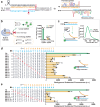Cas12a Cis-cleavage mediated lateral flow assay enables multiplex and ultra-specific nucleic acid detection
- PMID: 40593618
- PMCID: PMC12219710
- DOI: 10.1038/s41467-025-60917-9
Cas12a Cis-cleavage mediated lateral flow assay enables multiplex and ultra-specific nucleic acid detection
Abstract
CRISPR technology holds significant promise for advancing nucleic acid assays. However, current CRISPR diagnostic techniques, reliant on indiscriminate trans-cleavage mechanisms, face challenges in developing multiplex detection formats. Moreover, chaotic trans-cleavage activity often results from mismatched targets, leading to specificity issues. To address these limitations, here we exploit a double-key recognition mechanism based on CRISPR-Cas12a cis-cleavage and invasive hybridization identification of released sticky-end DNA products. By integrating multiplexed nucleic acid amplification, the double-key Cas12a detection mechanism, and a lateral flow detection platform, we develop a method termed Cas12a cis-cleavage mediated lateral flow assay (cc-LFA). We demonstrate that the cc-LFA exhibited superior specificity compared to three mainstream trans-cleavage-based CRISPR diagnostic techniques, achieving single-base resolution detection free from high-concentration wild-type DNA background interference. cc-LFA is also applied for highly specific detection of multiple respiratory pathogen samples and precise multiplexed detection of nine high-risk human papillomavirus (HPV) subtypes, achieving over 90% sensitivity and 100% specificity, respectively. Additionally, we present a portable device to automate nucleic acid amplification and strip detection procedures, showcasing the potential of cc-LFA for future applications in decentralized laboratory scenarios.
© 2025. The Author(s).
Conflict of interest statement
Competing interests: X.M.Z. and M.L. filed a patent application (202410070660.0.) based on the method presented in this work. The remaining authors declare no competing interests.
Figures







Similar articles
-
Unleashing high trans-substrate cleavage kinetics of Cas12a for nucleic acid diagnostics.Nucleic Acids Res. 2025 Jul 19;53(14):gkaf712. doi: 10.1093/nar/gkaf712. Nucleic Acids Res. 2025. PMID: 40716775
-
Specific detection of DNA and RNA by the CRISPR-Cas12a system containing spacer split crRNA.Anal Chim Acta. 2025 Sep 15;1367:344204. doi: 10.1016/j.aca.2025.344204. Epub 2025 May 17. Anal Chim Acta. 2025. PMID: 40610153
-
A dual fluorescence channel RAA-based CRISPR-Cas12a/Cas13a system for highly sensitive detection of Gyrovirus galga1 and Gyrovirus homsa1.Virulence. 2025 Dec;16(1):2521012. doi: 10.1080/21505594.2025.2521012. Epub 2025 Jun 22. Virulence. 2025. PMID: 40544408
-
CRISPR/Cas12a-Based Biosensing: Advances in Mechanisms and Applications for Nucleic Acid Detection.Biosensors (Basel). 2025 Jun 4;15(6):360. doi: 10.3390/bios15060360. Biosensors (Basel). 2025. PMID: 40558442 Free PMC article. Review.
-
Viral detection using Clustered Regularly Interspaced Short Palindromic Repeats/CRISPR-associated protein and Argonaute nucleases.Clin Chim Acta. 2025 Aug 7;578:120526. doi: 10.1016/j.cca.2025.120526. Online ahead of print. Clin Chim Acta. 2025. PMID: 40763823 Review.
References
-
- Chertow, D. S. Next-generation diagnostics with CRISPR. Science360, 381–382 (2018). - PubMed
-
- Li, Y. et al. CRISPR/Cas Systems towards next-generation biosensing. Trends Biotechnol.37, 730–743 (2019). - PubMed
-
- Patchsung, M. et al. Clinical validation of a Cas13-based assay for the detection of SARS-CoV-2 RNA. Nat. Biomed. Eng.4, 1140–1149 (2020). - PubMed
MeSH terms
Substances
Grants and funding
LinkOut - more resources
Full Text Sources

